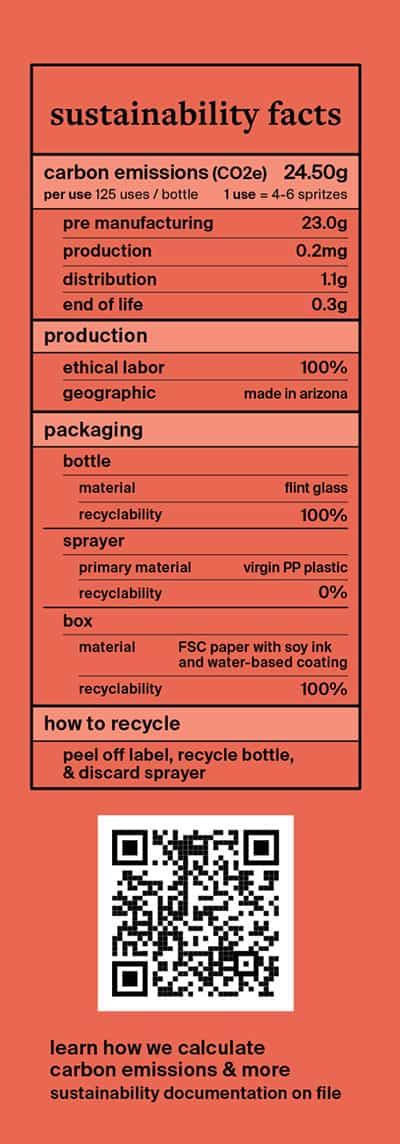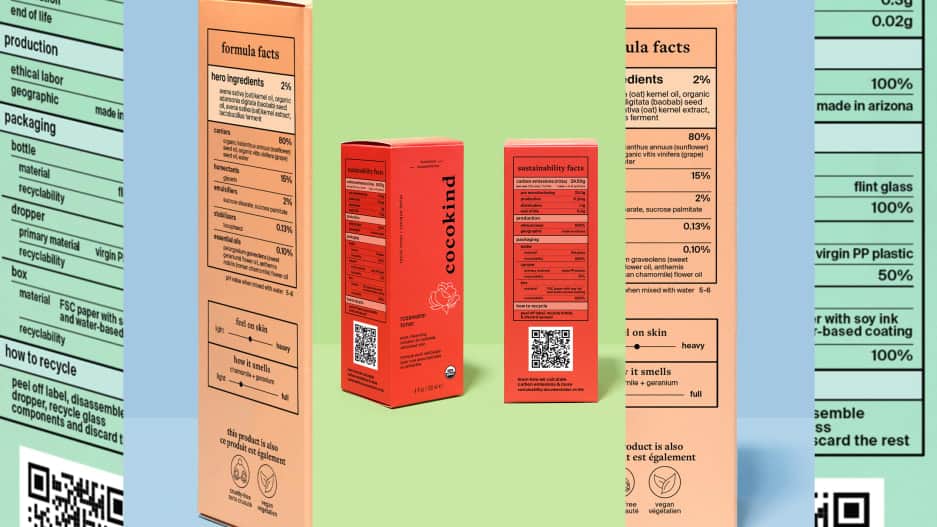Several companies are now offering consumers a way to see the full footprint of the product they’re using—but an accurate measurement can be hard.
On one side of a package from the indie beauty brand Cocokind, there’s a long list of sustainability facts laid out like a nutrition label. The product inside has a carbon footprint of 24.50 grams per use, it explains. It’s a carbon label, and the brand is one of several companies to begin using them.
“We were calling ourselves ‘clean’ and ‘sustainable,’” says founder Priscilla Tsai. “Those things are valid, but what they mean are obviously not regulated as they get thrown around more and more in the industry. We realized we can’t just use these words anymore, and we needed to be able to figure out, how do we measure this internally? And how do we communicate that, and make sure that the burden of education is on the brand and not the consumer?”
 The label also includes details about the packaging—the sprayer device inside the glass bottle isn’t recyclable, for example—but the most detailed breakdown is about the carbon footprint, calculating the emissions throughout the product’s lifecycle. If someone scans the QR code on the box, they can see more details. The brand plans to help consumers understand what the data means by comparing emissions to other sources such as driving a car, since “25 grams of CO2” doesn’t mean much to nonscientists.
The label also includes details about the packaging—the sprayer device inside the glass bottle isn’t recyclable, for example—but the most detailed breakdown is about the carbon footprint, calculating the emissions throughout the product’s lifecycle. If someone scans the QR code on the box, they can see more details. The brand plans to help consumers understand what the data means by comparing emissions to other sources such as driving a car, since “25 grams of CO2” doesn’t mean much to nonscientists.
Carbon labeling is a growing trend, says Euan Murray, chief executive of the Sustainability Consortium, a nonprofit that works with consumer goods companies to help them improve sustainability. “We are seeing challenger brands like Oatly use carbon labeling as part of their brand positioning, as well as corporate titans like Unilever commit to labeling all 70,000 of its products,” he says. “This will increasingly become mainstream, and I expect we will quickly get to the point where consumers expect to see this sort of information, just like they see fuel economy figures when buying cars and nutritional information when buying food.”
When the salad chain Just Salad started adding carbon labels to its menu in September 2020 and created a new “climatarian” section for the lowest-carbon foods, sales of those low-carbon foods jumped up by more than 20%. “We also saw these items’ share of total sales increase,” says Sandra Noonan, the company’s chief sustainability officer. The company is currently studying whether the trends will last long-term and partnering with university researchers to study how the labels impact customer behavior. In addition, the process of creating the labels has helped the company better understand its impact. “While we already knew that meat and dairy have higher carbon footprints than plant-based foods, the process of carbon labeling our menu gave us a granular understanding of this—for example, we can now estimate the impact that a particular dairy-based dressing contributes to a salad’s carbon footprint, versus a non-dairy-based dressing,” Noonan says.
It’s challenging to accurately estimate the carbon footprint of any particular product. “The sugar content of a glass of orange juice is pretty much constant,” says Murray. “And, if required, it can be measured in a lab. But the carbon footprint of a glass of orange juice changes constantly, depending on things like the time of year, where the oranges came from, the source of the energy used in the factory, and even how long the customer kept the juice in the fridge before drinking it. All these things mean the carbon footprint isn’t a scientific measurement—it is a calculation.” Companies can pull estimates from databases, though it’s more accurate to measure what’s happening with specific suppliers, as the fast-food chain Sweetgreen did when it recently calculated its own carbon footprint. (For now, Sweetgreen isn’t putting carbon labels on its menu and is just using the data to make plans to cut its emissions.)
If only a handful of companies publish the data, it’s also difficult for customers to make use of it—there’s no way to easily compare products, though it can serve as a sign that a company is at least beginning to understand its total impact. But over time, as it becomes more common, it could become a more useful tool. “Today, we are at the stage where companies are proactively choosing to include carbon footprint information, primarily as a way to burnish their green credentials and enhance their brand,” Murray says. “But as this information becomes more widespread, it’ll help create a race to the top, where companies work hard to reduce the impact of their products year-on-year. And consumer awareness, literacy, and willingness to act will all grow over time.”
Murray thinks that it will become easier to compare products based on their carbon footprints. “We are already seeing the launch of smartphone apps, rating websites, and other smart tools that help customers customize, pre-filter, and prioritize their shopping experience based on carbon and sustainability,” he says. “These sorts of innovations are going to be so important, so that we don’t end up with a system where every shopper needs a PhD. We just need to give folks the tools so they can understand the basics and build a working knowledge of what their most impactful choices are. That’s what success looks like.”
Packaging 360 is a comprehensive knowledge sharing ecosystem for the Indian packaging industry. Our services include an online content platform to deliver news, insights and case studies; organising conferences seminars and customised training; Providing Bespoke Project Consulting, Market Research and Intelligence.







